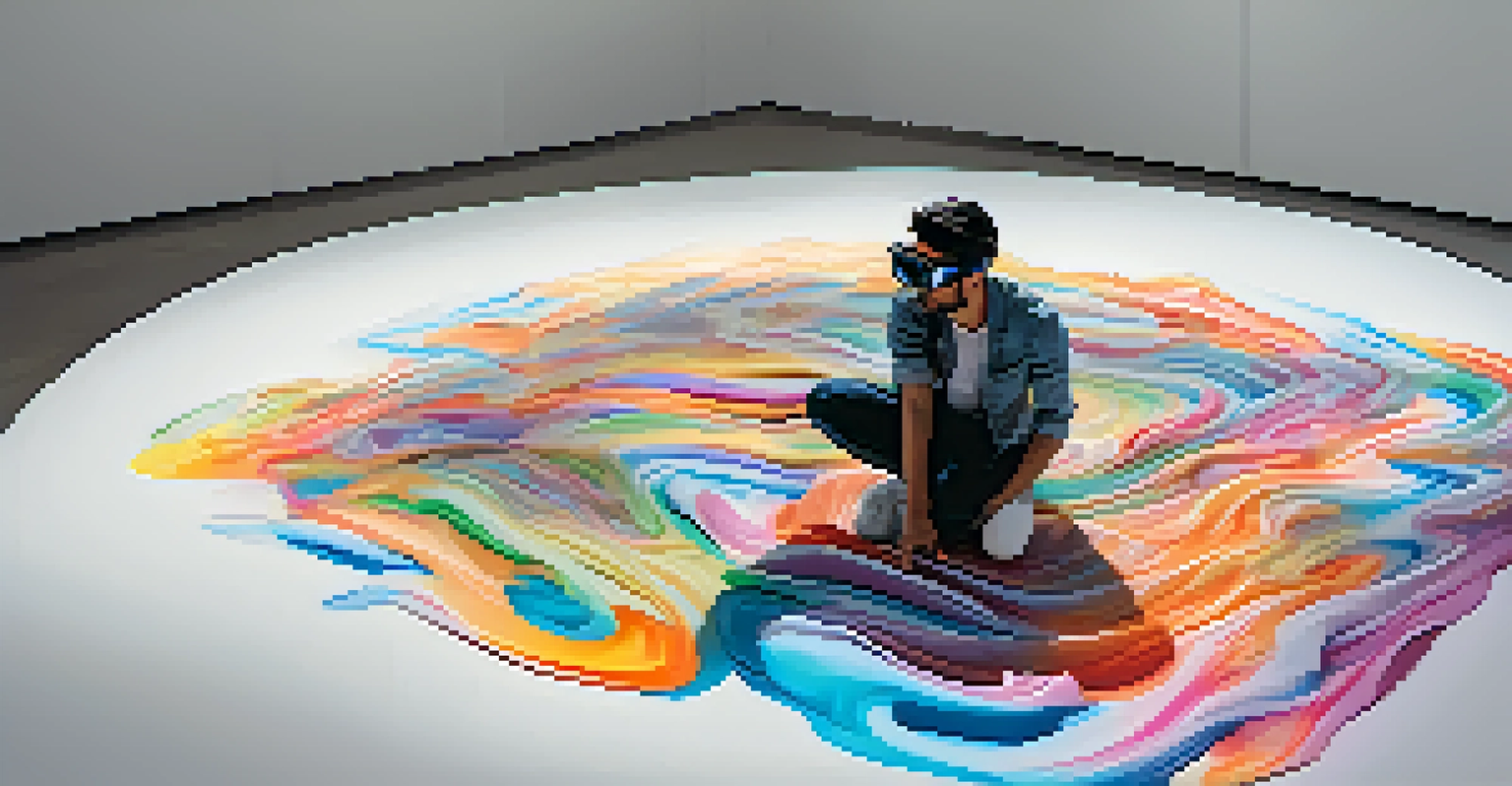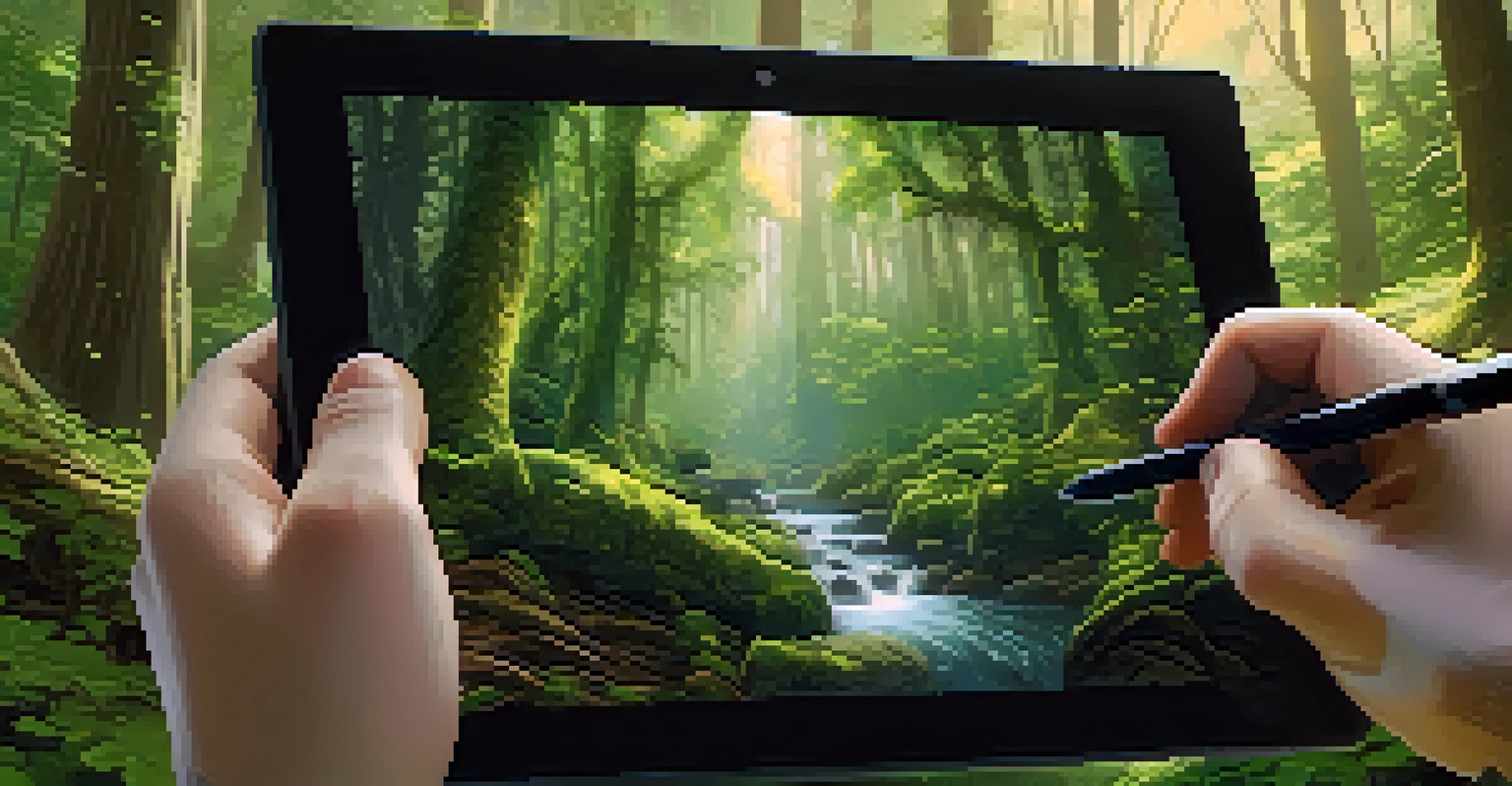Exploring the Intersection of Digital Arts and Technology Today

The Rise of Digital Arts in the 21st Century
Digital arts have gained significant traction in the 21st century, reshaping how we create and consume art. Artists are now using software, graphics tablets, and virtual reality to push traditional boundaries. This shift has opened up new avenues for expression, allowing for innovative forms that were once unimaginable.
Art is not freedom from discipline, but disciplined freedom.
For example, digital painting has become a popular medium, enabling artists to create stunning visuals without the constraints of physical materials. The ability to easily edit and manipulate images has made it a favorite choice for both hobbyists and professionals. This accessibility means that anyone with a computer can explore their artistic potential.
Moreover, the internet has played a pivotal role in democratizing art. Platforms like Instagram and Behance allow artists to showcase their work to a global audience, breaking down the barriers of geography and traditional galleries. This connectivity fosters a diverse community where artists can inspire and learn from each other.
Technology as a Tool for Creative Expression
Technology is not just a medium; it's a powerful tool that enhances artistic expression. With advancements in software and hardware, artists can experiment with new techniques and styles. For instance, 3D modeling software allows artists to create intricate sculptures and designs that can be brought to life through 3D printing.

Additionally, augmented reality (AR) and virtual reality (VR) have transformed the landscape of interactive art. Artists can create immersive experiences that engage the audience in ways that traditional art cannot. Imagine walking through a virtual gallery where you can interact with the artwork, altering it with your movements.
Digital Art's Expanding Influence
The rise of digital arts has transformed creative expression, allowing artists to explore innovative techniques and connect with global audiences.
These technologies also enable collaboration across disciplines, merging art with fields like science and engineering. This intersection leads to innovative projects that challenge our perceptions and inspire new ways of thinking about both art and technology.
The Impact of Social Media on Digital Arts
Social media platforms have revolutionized how artists share their work and connect with audiences. Sites like TikTok and Instagram allow for instant feedback and engagement, making the creative process more collaborative. Artists can showcase their work in progress, inviting followers into their creative journey.
The great thing about digital art is that it allows you to experiment without the fear of making a mistake.
This visibility can lead to opportunities that were previously hard to come by. Many artists have gained recognition and even lucrative commissions through their online presence. The viral nature of social media means that a single post can catapult an artist into the spotlight overnight.
However, this rapid exposure also comes with challenges. Artists may feel pressure to produce content frequently to maintain their audience, which can lead to burnout. Balancing creativity with the demands of social media is an ongoing struggle for many in the digital arts community.
The Role of Artificial Intelligence in Art Creation
Artificial intelligence (AI) is increasingly influencing the art world, pushing the boundaries of creativity. AI algorithms can analyze vast amounts of data to generate original pieces of art, music, or literature. This innovative approach raises intriguing questions about authorship and the nature of creativity itself.
For instance, platforms like Runway ML allow artists to experiment with AI-driven tools that can enhance their creative process. Artists can use these tools to generate new ideas or even co-create pieces alongside AI, blurring the lines between human and machine-generated art.
AI's Role in Artistic Creation
Artificial intelligence is reshaping the art landscape by enabling artists to co-create with algorithms, challenging traditional notions of authorship.
While some view AI as a threat to traditional artistry, many artists embrace it as a new form of collaboration. This partnership offers exciting possibilities, encouraging us to rethink what it means to be an artist in the digital age.
The Growing Importance of Digital Art Education
As digital arts continue to evolve, so does the need for education in this field. Many institutions are now offering specialized programs that focus on digital art techniques and technology integration. This educational shift equips aspiring artists with the skills necessary to thrive in a rapidly changing industry.
Online courses and tutorials have also made it easier than ever for individuals to learn at their own pace. Platforms like Skillshare and Coursera provide access to expert-led classes on everything from digital painting to animation. This accessibility helps to foster a diverse range of voices in the digital arts community.
Moreover, mentorship programs and online communities provide invaluable support for emerging artists. These networks encourage collaboration and skill-sharing, creating an environment where creativity can flourish. By investing in education, we can ensure that the next generation of artists is well-prepared to navigate the digital landscape.
Challenges Faced by Digital Artists Today
Despite the opportunities that come with digital arts, artists face significant challenges in today's landscape. One of the primary concerns is the issue of copyright and ownership. As digital art can be easily copied and shared, protecting one's work has become increasingly complex.
Moreover, the saturation of the digital art market can make it difficult for individual artists to stand out. With countless creators vying for attention online, finding a unique voice and audience can feel overwhelming. Artists often grapple with self-doubt and the fear of not being 'good enough.'
Education Shapes Future Artists
With the evolution of digital arts, specialized education and online resources are essential for nurturing the next generation of artists.
Additionally, the rapid pace of technological change means that artists must constantly adapt to new tools and trends. This ongoing learning curve can be daunting, especially for those who may not have a background in technology. Balancing artistic integrity with market demands is an ongoing struggle for many.
Future Trends in Digital Arts and Technology
Looking ahead, the future of digital arts and technology is brimming with potential. Emerging technologies like blockchain are beginning to reshape how art is bought and sold, introducing concepts like non-fungible tokens (NFTs). These digital assets provide artists with new revenue streams and ways to connect with collectors.
Additionally, the integration of immersive technologies like VR and AR is set to expand the horizons of artistic expression. We can expect to see more interactive installations that invite viewers to participate actively in the art experience. This shift towards engagement can lead to a deeper connection between the artist and the audience.

As we navigate this evolving landscape, one thing is clear: the intersection of digital arts and technology will continue to inspire and challenge us. Embracing these changes allows artists to explore new forms of creativity, ensuring that the art world remains vibrant and dynamic.